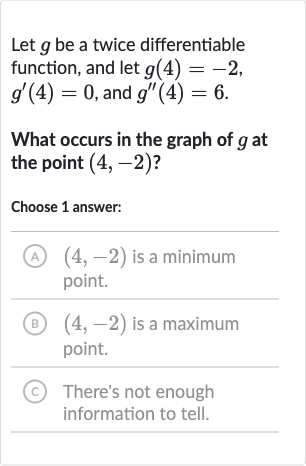Full solution
Q. Let be a twice differentiable function, and let , , and .What occurs in the graph of at the point ?Choose answer:(A) is a minimum point.(B) is a maximum point.(C) There's not enough information to tell.
- Given Information: We are given that is a twice differentiable function, and we have the following information about and its derivatives at :
-
-
-
The value of tells us the -coordinate of the point on the graph of at . The value of tells us that the slope of the tangent to the graph of at is zero, which means the graph has a horizontal tangent line at this point. This could indicate a local maximum, a local minimum, or a point of inflection.
The value of tells us the concavity of the graph at . Since is positive, the graph of is concave up at . This means that the point is a local minimum because the graph is shaped like a "U" around this point.

